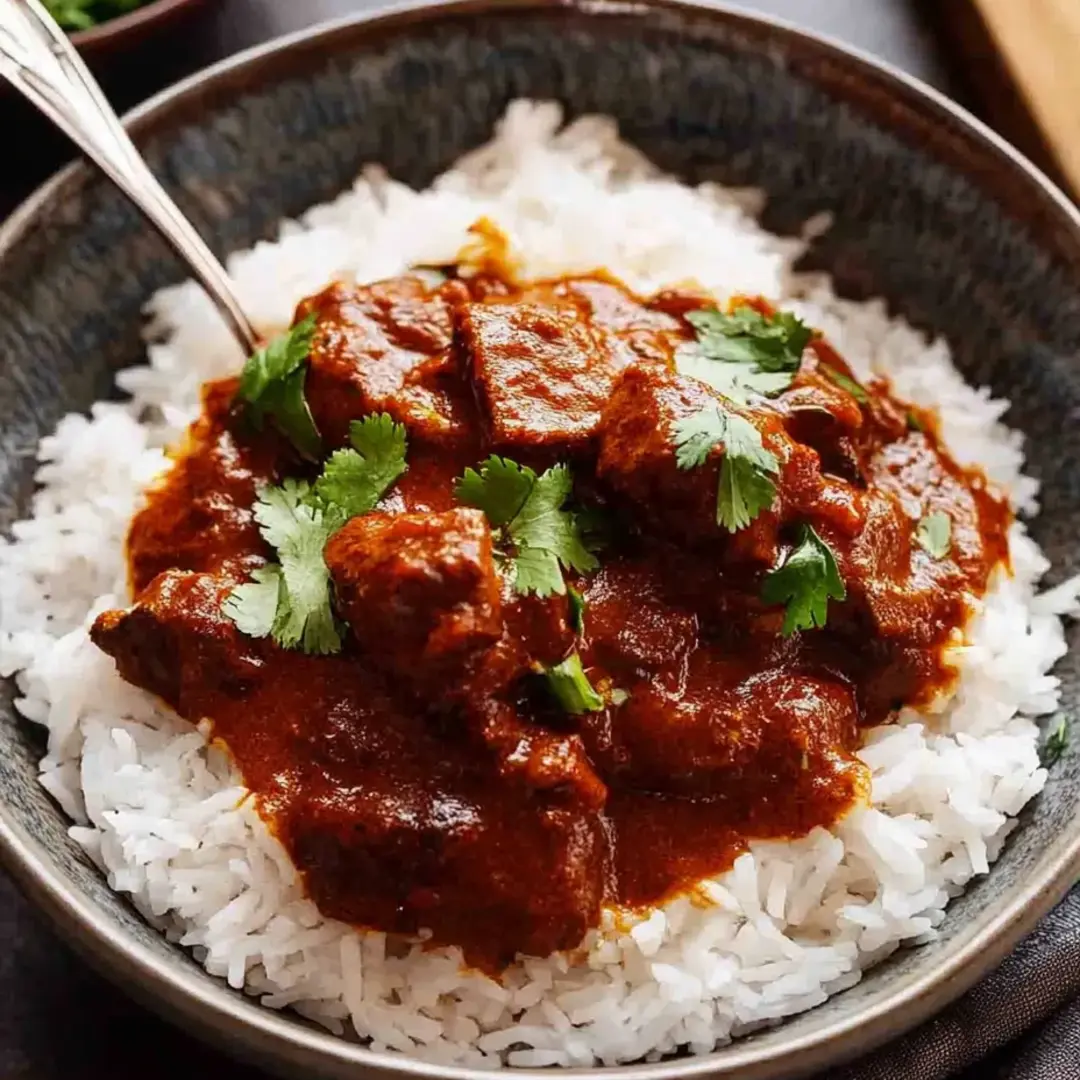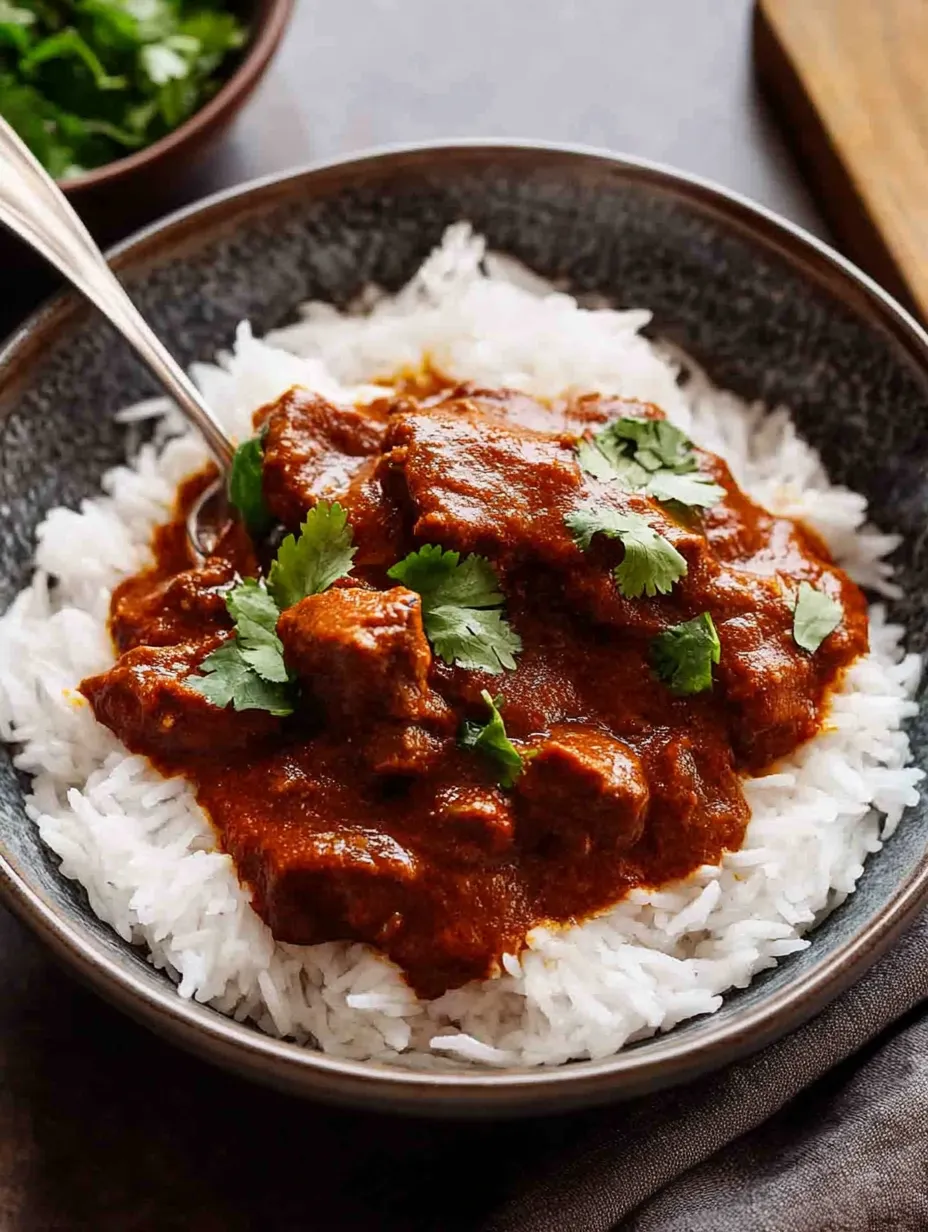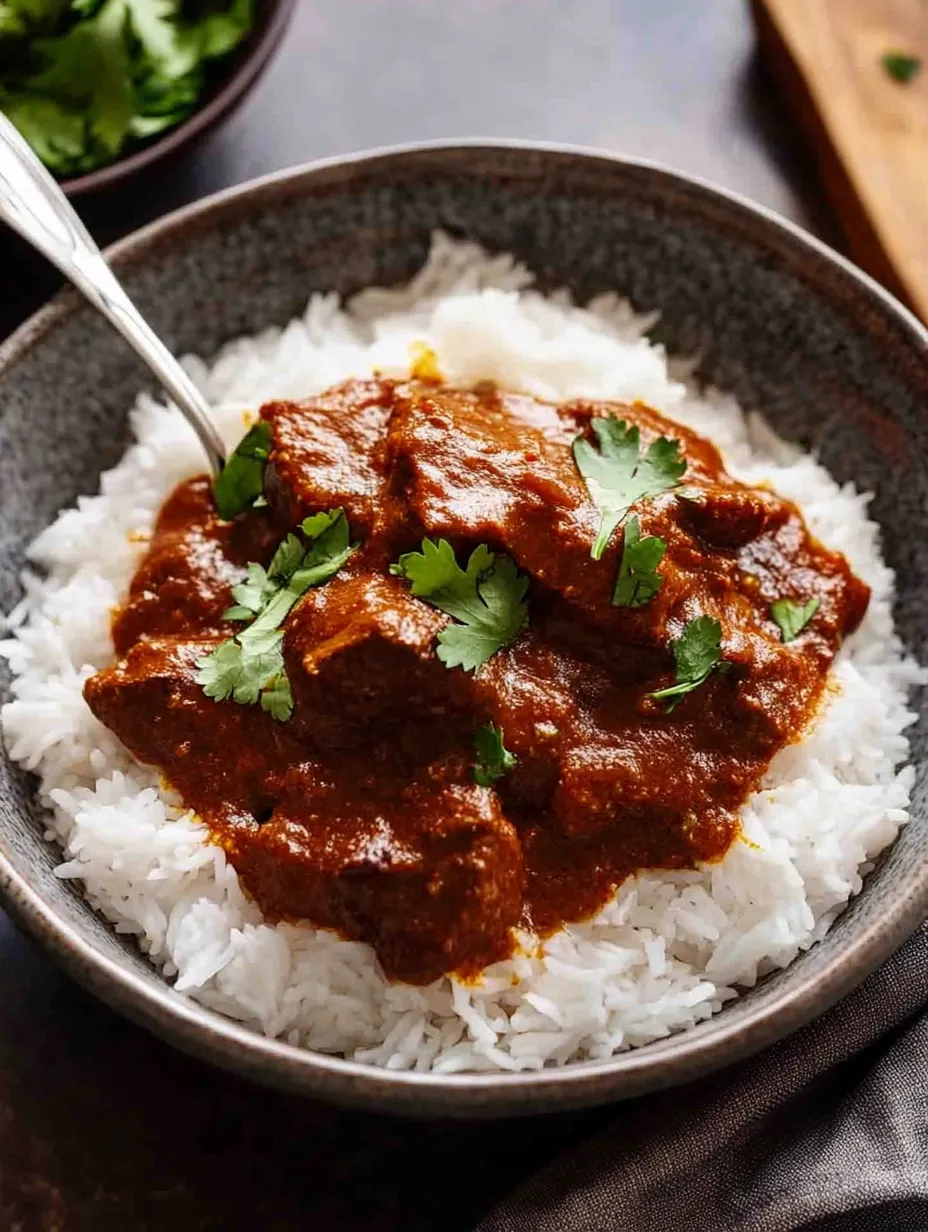 Pin it
Pin it
This bold Vindaloo Beef Curry delivers a magnificent explosion of flavors that serious curry lovers will appreciate. Chunks of beef simmer slowly until fork-tender in a vibrant red sauce packed with aromatic spices, a signature tanginess from vinegar, and a generous kick of heat from Kashmiri chili. The rich, complex flavors develop during the long cooking process, resulting in a curry that's deeply satisfying and authentically spicy. While definitely not for the faint-hearted, this curry represents the true essence of traditional Goan cuisine – fiery, intense, and completely unforgettable.
I made this Vindaloo for my brother-in-law who spent three years working in Mumbai and claims to be a curry expert. He took one bite, closed his eyes, and declared it was the most authentic Vindaloo he'd tasted outside of India. What surprised me most was how the vinegar and spices balanced each other so perfectly – creating that distinctive tang that sets Vindaloo apart from other curries. Even my spice-cautious husband managed to enjoy a small portion with plenty of yogurt on the side!
Key Ingredients
- Beef chuck: Choose a well-marbled piece and cut it into larger 3cm/1.2" cubes yourself; the slow-cooking transforms this economical cut into tender, flavorful morsels
- Kashmiri chili powder: The star ingredient that gives Vindaloo its signature bright red color and moderate heat without overwhelming spiciness; it's worth seeking out for its unique smoky-sweet profile
- Vinegar: Provides the distinctive tangy backbone that makes Vindaloo unique among curries; white vinegar works perfectly but apple cider vinegar adds subtle complexity
- Fenugreek seeds: These maple-scented seeds contribute an indefinable depth that's subtly sweet and slightly bitter; they're part of what makes the curry taste authentically Indian
- Curry leaves: Fresh leaves add an incredible aromatic quality that can't be replicated with powder; their citrusy, slightly bitter notes are quintessentially Indian
- Black mustard seeds: They add little pops of texture and a wasabi-like zing that brightens the rich sauce; listen for the delightful popping sound as they hit the hot oil
- Ghee: This clarified butter adds a nutty richness that regular cooking oils simply can't match; it's worth using the real thing here
- Ginger and garlic: These aromatics form the foundation of almost all Indian curries; use fresh for the most vibrant flavor possible
- Beef stock: Adds depth to the sauce beyond what water alone can provide; even store-bought is fine as the spices are the dominant flavor
 Pin it
Pin it
Detailed Cooking Instructions
- Step 1:
- Begin by preparing the Vindaloo curry paste marinade. In a small food processor or blender, combine 6 tablespoons Kashmiri chili powder, 1 tablespoon ground cumin, 1 tablespoon ground coriander, 1 teaspoon ground turmeric, 2 teaspoons fenugreek seeds, 8 cardamom pods (seeds only), 1 cinnamon stick (broken), 1 teaspoon black peppercorns, 6 cloves garlic (roughly chopped), 2 tablespoons fresh ginger (roughly chopped), 1/3 cup white vinegar, 2 teaspoons sugar, 1 teaspoon salt, and 3 tablespoons water. Blend until completely smooth, stopping to scrape down the sides as needed. The paste should be vibrant red and have a thick, spreadable consistency.
- Step 2:
- Cut 1kg (2lb) beef chuck into 3cm/1.2" cubes, ensuring they're all roughly the same size for even cooking. Place the beef in a large bowl, pour the curry paste over it, and use your hands (with gloves) or a spatula to thoroughly coat each piece. Cover and refrigerate for at least 2 hours or up to 24 hours. This marination time allows the vinegar to begin tenderizing the meat and the spices to penetrate the surface.
- Step 3:
- When ready to cook, preheat your oven to 190°C/375°F (170°C fan). The higher temperature might seem surprising for slow cooking, but it replicates a very gentle simmer on the stovetop, perfect for developing the sauce flavor while tenderizing the meat.
- Step 4:
- Heat 2 tablespoons ghee or butter in a large, heavy-bottomed Dutch oven over medium heat. Add 1 large finely diced onion and cook for 5 minutes until softened but not browned. Add 1 tablespoon minced garlic and 1 tablespoon minced ginger, stirring constantly for 1 minute until fragrant. The aroma will shift from sharp to sweet as they cook.
- Step 5:
- Add 2 teaspoons black mustard seeds to the pot. They will begin to pop and dance in the hot ghee – this is exactly what you want! This process releases their flavor and creates those little bursts of texture in the finished dish. Then add 10-12 fresh curry leaves (if using) and cook for 30 seconds until they become fragrant and slightly crisp.
- Step 6:
- Stir in 3 tablespoons tomato paste and cook for 2 minutes, stirring constantly to prevent burning. This brief cooking removes the raw tomato flavor and begins to caramelize the sugars, adding depth to the final sauce. Then add 2 cups beef stock and stir well to combine, scraping up any browned bits from the bottom of the pot.
- Step 7:
- Transfer this sauce base to a jug and use a stick blender to puree until completely smooth. This step is crucial for creating a silky sauce texture and releasing maximum flavor from the aromatics. Return the pureed sauce to the pot.
- Step 8:
- Add the marinated beef and all of the marinade to the pot, stirring well to combine. Bring the mixture to a simmer on the stovetop, then cover with a tight-fitting lid and transfer to the preheated oven. Cook for 2 hours, undisturbed. This hands-off cooking time allows the beef to slowly become tender while the sauce develops its signature rich flavor and vibrant color.
- Step 9:
- After 2 hours, carefully remove the pot from the oven. The beef should be fork-tender, nearly falling apart when pressed. The sauce should have thickened significantly and deepened to a rich, reddish-brown color. If the beef isn't quite tender enough, return it to the oven for an additional 15-30 minutes.
- Step 10:
- Taste and adjust seasoning if necessary. The flavor should be intensely spiced with a noticeable vinegar tang. If the balance isn't quite right, you can add a touch more salt, a pinch of sugar to round out any sharpness, or even a splash more vinegar if you want to emphasize the tanginess.
- Step 11:
- Allow the curry to rest for 10 minutes before serving. This brief resting time allows the beef to reabsorb some liquid and the flavors to settle. Garnish with fresh coriander leaves for a pop of color and fresh flavor contrast.
- Step 12:
- Serve hot over steamed basmati rice, with warm naan bread for mopping up the sauce and a generous dollop of plain yogurt on the side to cool the heat for those who might need it.
The History Behind the Heat
The fascinating history of Vindaloo reflects the rich cultural exchanges that have shaped Indian cuisine. Originally a Portuguese dish called 'carne de vinha d'alhos' (meat marinated in wine and garlic), it was transformed by the local cooks of Goa when Portugal colonized this coastal region in the 16th century. They substituted vinegar for the wine (as grapes weren't readily available) and added their local spices, creating something entirely new and magnificent. The name 'Vindaloo' is actually a linguistic corruption of the original Portuguese name. I love sharing this bit of culinary history when serving this dish – it helps guests appreciate how food evolves through cultural exchange and local adaptation.
 Pin it
Pin it
Balancing the Fire
While authentic Vindaloo should definitely pack a punch, you can adjust the heat level without compromising the essential character of the dish. I've experimented with various adaptations for friends with different spice tolerances. For a milder version that still maintains the Vindaloo essence, reduce the Kashmiri chili to 3-4 tablespoons and add 2 tablespoons of sweet paprika to maintain the vibrant color. Another approach is to keep the spice level authentic but serve cooling accompaniments – a cucumber raita (yogurt mixed with grated cucumber, mint, and a pinch of cumin) works wonders alongside the heat of Vindaloo. Remember, the goal isn't to eliminate the spice entirely – that distinctive heat is part of what makes Vindaloo special.
Making it Ahead
Vindaloo is one of those magical dishes that actually improves with time, making it perfect for entertaining. I often make mine a day ahead, cool it completely, then refrigerate overnight. The flavors meld and deepen, and the sauce thickens to that perfect consistency. When ready to serve, I gently reheat it on the stovetop, adding a splash of beef stock if needed to loosen the sauce. This approach not only enhances the flavor but also eliminates last-minute cooking stress when hosting. The curry will keep beautifully in the refrigerator for up to 3 days, and it freezes exceptionally well for up to 3 months – perfect for meal planning or preparing for large gatherings.
I learned from an Indian chef friend that adding a small, grated apple to the sauce about 30 minutes before the end of cooking adds a subtle sweetness that beautifully balances the heat and acidity. This isn't traditional, but it's become my secret ingredient that always has guests trying to identify that mysterious depth in the sauce!
This Vindaloo Beef Curry has become much more than just a recipe in my household – it's a celebration of bold flavors and the joy of slow cooking. There's something deeply satisfying about the process: the aromatic spices filling the kitchen, the gradual transformation of humble ingredients into something extraordinary, and finally, the reward of that first spicy, tangy, intensely flavorful bite. While it might not be an everyday dish for most, it's the perfect choice when you want to create something truly special – a meal that respects tradition while delivering an unforgettable experience. And isn't that what great cooking is all about?
Frequently Asked Questions
- → How spicy is this Beef Vindaloo?
- This recipe rates 7-8 out of 10 on the spiciness scale. It's properly spicy but not painfully hot. You can adjust the heat level by reducing the Kashmiri chili powder and replacing it with a mix of sweet and smoked paprika.
- → Can I make this in a slow cooker or Instant Pot?
- Unfortunately, this recipe doesn't work well in slow cookers or pressure cookers. The oven method is essential for caramelizing the edges of the sauce, which adds flavor and helps thicken it properly.
- → What can I substitute for Kashmiri chili powder?
- If you can't find Kashmiri chili powder, substitute with 4 tablespoons of smoked paprika plus 1 teaspoon of regular chili powder or cayenne pepper. The flavor will be similar, though the color won't be quite as vibrant red.
- → What cut of beef works best for Vindaloo?
- Beef chuck is ideal because it becomes fall-apart tender after slow cooking. Other good options include boneless ribs, well-marbled brisket, or beef osso bucco. Lamb or pork shoulder would also work well.
- → How long will leftovers keep?
- Leftovers will keep for up to 5 days in the refrigerator. However, unlike Western stews, curries are best eaten on the day they're made or the day after, as the intensity of the spice flavors starts to fade after that.
